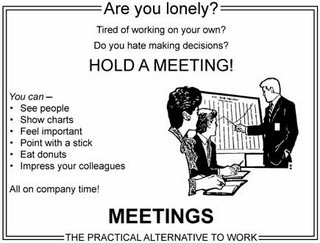 Meetings are probably a very controversial topic in the everyday company world, and it’s just as controversial when it comes to software development. Meetings can suck the time out of your week and the life out of you if done wrong.
Meetings are probably a very controversial topic in the everyday company world, and it’s just as controversial when it comes to software development. Meetings can suck the time out of your week and the life out of you if done wrong.
However, if done right, meetings can be one of your best tools for communication and knowledge transfer. In my opinion you just have to remember a few simple rules and think about meetings coming in a very limited variation of flavors.
The purpose: Result or information driven
When I say that meetings can be either result or information driven, I mean that the goal of the meeting can either be to reach a specific result or to pass on information (or both). Working in an agile information, I am in both kind of meetings all the time.
A typical planning meeting is result driven. At the end of the meeting we are supposed to have decided on the user stories the team will we working on for the next couple of weeks. We usually have small design sessions during a sprint, whose intended result is a working and agreed design.
On the other hand, we regularly have meetings where the main point is to get information across. Usually these are cross-team meetings, but daily scrums could also be seen as mostly information driven.
In most every case the purpose of a meeting is a bit of both, but it should at least be one or the other. In other words: Be clear what the goal or purpose of your meeting is and make sure that others understand it. It’s only fair to the people who attend your meeting to know in advance what they’re in for and what they can expect.
The style: Discussion or presentation
The style of a meeting can also vary. It can either be a discussion where everyone is invited to throw in their opinion and discuss a certain topic. Or it can be held in a more presentation-like style, with one or more people presenting while other attendants may discuss key points or ask questions.
Again, there’s not one or the other, but rather a mixture of both styles. A presentation without a bit of discussion will easily bore other people, while a discussion without a bit of a presentation of the issues to discuss will likely get out of hand when nobody knows for sure what the meeting is about.
Just like with a meeting’s purpose, the style of a meeting should be clear, make sense and be properly communicate to the participants.
That’s it.
For me, that sums it up. Sure, you could argue that there’s a lot more to it, and there probably is, but going with these four characteristics – or basic meeting flavors – I find that I can easily describe the kind of meeting that is most helpful for any given situation.
And to leave you with a few more meeting wisdoms from my work experience, how about these two:
- Always, and I mean always, end a meeting with a result. Never wrap up a meeting without a follow-up e-mail, a list of action items, a working design or at the very least a set of notes. A result can also be to meet again (that would fall into the action item category) or to ensure that everyone is on the same page (get a short feedback from all participants and send out an email with the main points summarized). Never, ever leave a meeting empty-handed. For me, this is the best indicator that something went wrong with the purpose of the meeting.
Besides, meetings will be regarded less like a waste of time of it’s obvious to everyone that something came out of it. Getting a e-mail with a summary of all the discussed points will remind people that they didn’t waste their time being stuck in a room with too little air. - Make sure someone is the designated moderator for a meeting. Even for a meeting that is mostly a discussion or one which consists of several presentation by several people, there should be someone who acts as the owner of the meeting. That someone should start the meeting, wrap it up and make sure that there are no loose ends. You might be able to bend on this rule for more informal meetings, but be careful if you do.
If you do meetings right, they can be a helpful tool without getting on everybody’s nerves. Following a few simple rules should make that a bit easier.